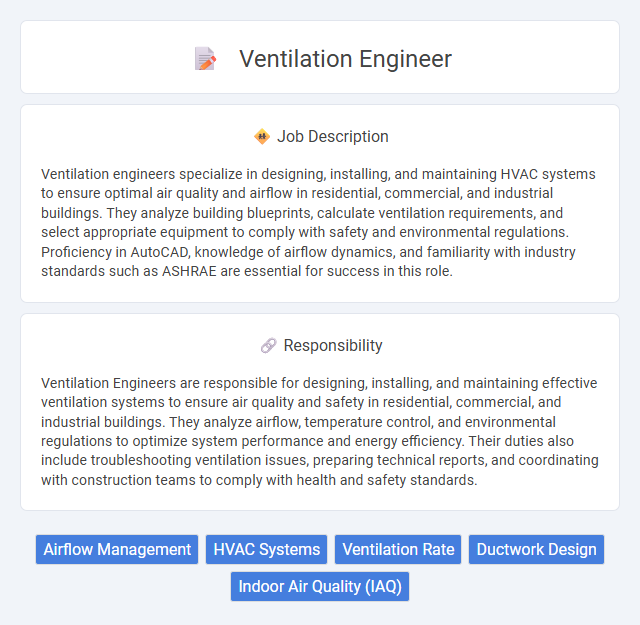
Ventilation engineers specialize in designing, installing, and maintaining HVAC systems to ensure optimal air quality and airflow in residential, commercial, and industrial buildings. They analyze building blueprints, calculate ventilation requirements, and select appropriate equipment to comply with safety and environmental regulations. Proficiency in AutoCAD, knowledge of airflow dynamics, and familiarity with industry standards such as ASHRAE are essential for success in this role.
Individuals with strong problem-solving skills and a comfort with working in physically demanding environments are likely suitable for a ventilation engineer role. Those who prefer routine, low-activity tasks may find the job challenging due to its hands-on nature and frequent site visits. Candidates possessing good spatial awareness and an interest in HVAC systems will probably thrive in this profession.
Qualification
A Ventilation Engineer must hold a degree in Mechanical Engineering, Environmental Engineering, or a related field, with relevant certifications such as HVAC Design or Building Services Engineering. Proficiency in CAD software, knowledge of ventilation system standards like ASHRAE, and experience with air quality control are critical qualifications. Expertise in project management and compliance with health and safety regulations enhances job performance in designing and maintaining optimal ventilation systems.
Responsibility
Ventilation Engineers are responsible for designing, installing, and maintaining effective ventilation systems to ensure air quality and safety in residential, commercial, and industrial buildings. They analyze airflow, temperature control, and environmental regulations to optimize system performance and energy efficiency. Their duties also include troubleshooting ventilation issues, preparing technical reports, and coordinating with construction teams to comply with health and safety standards.
Benefit
A career as a Ventilation Engineer likely offers numerous benefits, including strong job stability due to increasing demand for energy-efficient and health-conscious building systems. Professionals in this field probably enjoy competitive salaries and opportunities for advancement in sectors such as construction, HVAC design, and environmental engineering. The role may also provide the satisfaction of improving indoor air quality and contributing to sustainable building practices.
Challenge
A Ventilation Engineer probably faces complex challenges related to designing systems that ensure optimal indoor air quality while complying with strict environmental regulations. The role likely demands troubleshooting unexpected airflow issues and adapting solutions for diverse building layouts. Balancing energy efficiency with effective ventilation may present ongoing difficulties requiring innovative problem-solving skills.
Career Advancement
Ventilation engineers specializing in HVAC systems have strong career advancement potential in industries like construction, manufacturing, and healthcare, where building air quality and safety are critical. Gaining certifications such as Certified Ventilation Engineer (CVE) or Professional Engineer (PE) enhances expertise and opens opportunities for senior project management or consultancy roles. Mastery of advanced ventilation modeling software and sustainability practices significantly boosts job prospects in green building design and industrial safety compliance.
Key Terms
Airflow Management
Ventilation engineers specialize in designing and optimizing airflow systems for residential, commercial, and industrial buildings to ensure effective air quality and temperature control. They analyze airflow patterns, calculate ventilation rates, and implement HVAC solutions that enhance energy efficiency and comply with health and safety regulations. Expertise in airflow management is critical for preventing contaminants, ensuring proper exhaust, and maintaining balanced indoor environments.
HVAC Systems
Ventilation engineers specialize in designing, installing, and maintaining HVAC systems to ensure optimal indoor air quality and thermal comfort. Their expertise includes airflow analysis, ductwork design, and compliance with environmental and safety standards. Proficiency in software tools like AutoCAD and Revit enhances precision in developing energy-efficient ventilation solutions.
Ventilation Rate
Ventilation engineers specialize in designing and optimizing ventilation systems to ensure appropriate ventilation rates that improve indoor air quality and maintain thermal comfort. Proper ventilation rate calculations are essential to remove airborne contaminants, control humidity, and provide adequate fresh air for occupancy in commercial, residential, and industrial buildings. Advanced knowledge of HVAC systems, airflow dynamics, and regulatory standards like ASHRAE 62.1 is critical for achieving efficient and compliant ventilation solutions.
Ductwork Design
Ventilation engineers specializing in ductwork design create efficient airflow systems by calculating air volume, pressure drops, and selecting appropriate materials. Expertise in CAD software and compliance with HVAC standards ensures optimized duct layouts that enhance indoor air quality and energy efficiency. Precision in duct sizing and routing minimizes noise and system losses, crucial for residential, commercial, and industrial applications.
Indoor Air Quality (IAQ)
Ventilation engineers specialize in designing systems that enhance Indoor Air Quality (IAQ) by controlling airflow, humidity, and pollutant levels within buildings. They utilize advanced ventilation technologies and air filtration methods to reduce contaminants such as volatile organic compounds (VOCs), carbon dioxide, and particulate matter, ensuring healthier indoor environments. Expertise in ASHRAE standards and HVAC system optimization is critical for maintaining compliance and improving occupant comfort through effective air exchange and ventilation rates.
 kuljobs.com
kuljobs.com